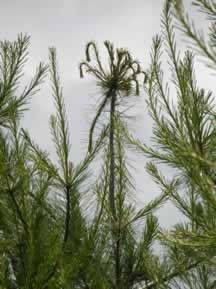DACF Home → Bureaus & Programs → Maine Forest Service → Forest Health & Monitoring → Insect & Disease Fact Sheets → White Pine Weevil → Pruning to manage white pine weevil
Pruning to manage white pine weevil
Printable Versions: (PDF | 723 KB), (WORD | 412 KB)
The white pine weevil, which kills the tops of conifers, is the most serious economic insect pest of white pine in Maine. Weevil attacks result in trees that are multi-topped, crooked, and of much lower value for sawtimber. Appearance and development of ornamental trees are also affected. Trees in open areas, plantations, and forest clearings are most severely damaged.
White pine weevil most commonly attacks eastern white pine, jack pine, and Norway spruce. However, many other pines and spruces, including ornamentals, are also susceptible.
One of the first symptoms of attack in the spring is the presence of pitch flowing from feeding punctures in the previous year's leading shoot. Beginning in late June and early July, the new growth on infested shoots starts to droop. Shortly thereafter the tops die and turn brown. Up to 2-3 years of top growth may be destroyed.
- multi-stemmed white pine: http://www.forestryimages.org/browse/detail.cfm?imgnum=4212047
- young white pine attacked by weevil for several years:

- pitch dripping from feeding wounds on last year’s leader:

- early signs of wilt:

- damage later in the summer (shepherd’s crook): http://www.forestryimages.org/browse/detail.cfm?imgnum=0907018
Life Cycle
Starting in early spring, weevil eggs are laid in the bark of the previous year's leader. After hatching, the legless grubs start tunneling downward under the bark, eventually girdling the infested stem and killing the top 1 1/2 - 2 feet of the tree. Larvae pupate in the main stem, and by mid-July adults begin to emerge. To have any effect on weevil populations, pruning must be done before this time.
- Adult Weevil: https://apps.extension.umn.edu/garden/diagnose/plant/images/pine/wpw3_200px.jpg
- Larvae tunneling under bark of leader: http://www.forestryimages.org/browse/detail.cfm?imgnum=0907019
- Pupa:http://www.forestryimages.org/browse/detail.cfm?imgnum=5062006
Pruning of Infested Leaders
Pruning and destroying infested terminal shoots on young trees in late June and early July kills the current year’s generation of beetles, and can reduce attack in future years.
- PRUNE infested leaders (the topmost shoot) at a point just into healthy tissue below the tunneling grubs.
- DESTROY by promptly burning all cut leaders to kill the insects before adults emerge. DO NOT leave removed material on site, since weevils will develop and emerge from cut material.
WHEN TO PRUNE:
Wilting of leaders may be detected anytime after late June. Pruning should be completed when the wild raspberries start to ripen (early to mid-July, depending on your location), while weevils are still in the wilted or dead terminal shoot. Pruning before completion of shoot growth encourages secondary budding on the pruned leader and may result in faster terminal recovery. Early pruning can also remove the weevils when only a single year’s growth has been damaged, rather than two or three. Pruning after mid-July, once the adults have emerged, is not effective.
Corrective Pruning
After the removal of infested leaders, tops of trees should be pruned in such a manner that all but a single dominant shoot at the topmost healthy whorl are removed to encourage formation of a new leader. Corrective pruning may be postponed until the following year to make sure that at least one live lateral will survive possible damage (e.g. from ice, snow, or a second year of weevil attack).
corrective pruning: http://www.na.fs.fed.us/spfo/pubs/howtos/ht_white/white.htm (scroll down to last illustration)
Shade
Partial shade helps reduce weevil attack by reducing temperature and bark thickness. Leaving some overtopping hardwoods or other conifers may help protect young pine and spruce from weevil damage when they are most susceptible. Density of the overtopping species should be managed to maintain about 45-50% shade until final release when the trees reach a height of 16 to 18 feet. Closer spacing of trees in a plantation will stimulate height growth and natural pruning to permit faster recovery.
MAINE DEPARTMENT OF AGRICULTURE, CONSERVATION AND FORESTRY
Maine Forest Service - Forest Health and Monitoring Division
July 2007
For more information, see also:
Maine Forest Service: Forest Health and Monitoring Fact Sheet
US Forest Service: Forest Insect and Disease Leaflet 21
US Forest Service: How to Manage Eastern White Pine to Minimize Damage from Blister Rust and White Pine Weevil NA-FR-01-93